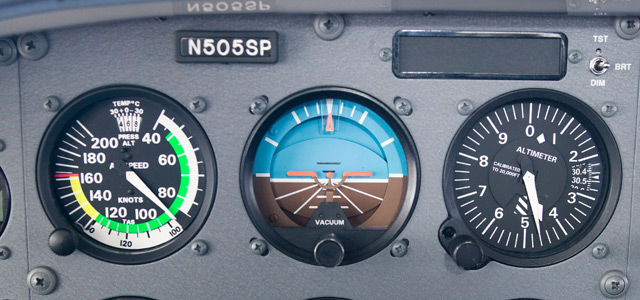
“Interpret the flight attitude,” dares a question in an instrument training text, alongside a graphic of a distressed instrument panel.
Remember that exercise? This picture wasn’t one of those panels so terribly tumbled that they give you vertigo just looking at them. Still, it wasn’t what you would want to see while cruising in a dense, dark deck.
The graphic shows a conventional vacuum-driven artificial horizon, with its miniature aircraft’s nose on the horizon, and the right wing slightly low. The directional gyro disagrees—its facial motion suggesting a left turn. The tiebreaking turn coordinator maintains a stoic, wings-level neutrality.
Three bank instruments, three indications. Which to believe?
Hold that thought.
If it’s a given that a VFR pilot is most vulnerable when called upon to fly solely by reference to instruments, the equivalent risk for an instrument pilot is to be deprived of some data that helps maintain control in IMC.
In both cases, you can be doing fine until another shoe drops. A pilot taking a checkride in a Cessna 172 shared that reminder in the Aviation Safety Reporting System.
“We were at 2,000 feet and partial panel when we flew into an area of heavy rain and downdraft conditions. During this time I lost control of the aircraft temporarily; first directional control and then lost about 700 to 800 feet,” reported the pilot, who was flying with the attitude indicator covered.
In the glass era, the familiar shorthand “partial panel” isn’t the way to describe system troubles. When technologically sophisticated aircraft send up flags of failure, the challenge may be how to transition safely from one display mode to another.
A pilot flying an RNAV GPS approach with an instructor in a Cessna 172SP NAVIII recounted to the ASRS that after “zooming in the multi-function display” following simulated primary flight display failure, the crewmembers lost situational awareness, and the aircraft “descended to 700 feet when (it) should have been at 1,600 feet.”
ATC broke the spell with a warning.
No surprise: Even after you upgrade from gyros to glass, lessons of teachable moments—think distraction—don’t change.
As for the aircraft with three different bank indications: It was in straight-and-level flight, as pitot-static instruments and the totally truthful turn coordinator testified.
But it took time to study the problem and satisfy oneself of that, more time than is sometimes available.



